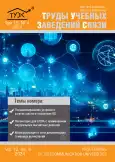Energy-Efficient Algorithm for Data Path Selection in High-Density Wireless Sensor Networks
- Authors: Astakhova T.N.1, Kolbanev M.O.2, Lyamin A.S.1, Maslov N.S.1, Maslova D.A.1
-
Affiliations:
- Nizhny Novgorod State Engineering and Economic University
- St. Petersburg State Electrotechnical University “LETI”
- Issue: Vol 10, No 4 (2024)
- Pages: 100-109
- Section: INFORMATION TECHNOLOGIES AND TELECOMMUNICATION
- URL: https://journals.rcsi.science/1813-324X/article/view/263511
- EDN: https://elibrary.ru/VPHYUT
- ID: 263511
Cite item
Full Text
Abstract
About the authors
T. N. Astakhova
Nizhny Novgorod State Engineering and Economic University
Email: ctn_af@mail.ru
ORCID iD: 0000-0002-7032-0697
SPIN-code: 2158-3392
M. O. Kolbanev
St. Petersburg State Electrotechnical University “LETI”
Email: mokolbanev@mail.ru
ORCID iD: 0000-0003-4825-6972
SPIN-code: 1474-4401
A. S. Lyamin
Nizhny Novgorod State Engineering and Economic University
Email: a.s.lyamin@gmail.com
ORCID iD: 0000-0003-0027-2404
SPIN-code: 3734-9940
N. S. Maslov
Nizhny Novgorod State Engineering and Economic University
Email: j-knaginino@yandex.ru
ORCID iD: 0000-0003-0209-7267
SPIN-code: 8517-4653
D. A. Maslova
Nizhny Novgorod State Engineering and Economic University
Email: dasha.kirilova.96@bk.ru
ORCID iD: 0000-0002-3329-4821
SPIN-code: 3658-7490
References
- Романова А.А. Модели и методы оценки вероятностно-энергетических характеристик информационного взаимодействия в интернете вещей. Автореферат дис. … канд. техн. наук. СПб.: Санкт-Петербургский государственный электротехнический университет "ЛЭТИ" им. В.И. Ульянова (Ленина), 2023. 21 с.
- Almuhaya M.A.M., Jabbar W.A., Sulaiman N., Abdulmalek S. A survey on LoraWAN Technology: Recent Trends, Opportunities, Simulation Tools and Future Directions // Electronics. 2022. Vol. 11. Iss. 1. P. 164. doi: 10.3390/electronics11010164
- Levchenko P., Bankov D., Khorov E., Lyakhov A. Performance Comparison of NB-Fi, Sigfox, and LoRaWAN // Sensors. 2022. Vol. 22. Iss. 24. P. 9633. doi: 10.3390/s22249633
- Зверев Б., Сартаков А. SNB новая LPWAN-технология «Интернета вещей» с высокой пропускной способностью // Control Engineering Россия. 2019. № S. С. 38‒41. EDN:JRNENT
- Астахова Т.Н., Верзун Н.А., Касаткин В.В., Колбанев М.О., Шамин А.А. Исследование моделей связности сенсорных сетей // Информационно-управляющие системы. 2019. № 5(102). С. 38–50. doi: 10.31799/1684-8853-2019-5-38-50. EDN:GLMGRC
- Татарникова Т.М., Бимбетов Ф., Горина Е.В. Алгоритм энергоэффективного взаимодействия узлов беспроводной сенсорной сети // Научно-технический вестник информационных технологий, механики и оптики. 2022. Т. 22. №. 2. С. 294‒301. doi: 10.17586/2226-1494-2022-22-2-294-301. EDN:FCHFEL
- Уоллес Р. Максимальная дальность связи по радиоканалу в системе: как этого добиться? // Новости электроники. 2015. № 11. С. 3.
- Колбанёв М.О., Татарникова Т.М. Физические ресурсы информационных процессов и технологий // Научно-технический вестник информационных технологий, механики и оптики. 2014. № 6(94). С. 113–123. EDN:TBDGTL
- Аунг Т.А. Разработка методов и средств защищенного сбора данных окружений Интернета Вещей (ИВ). Дис. … канд. техн. наук. СПб.: Национальный исследовательский университет ИТМО, 2020. 297 с. EDN:QTBXRI
- Астахова Т.Н., Кирилова Д.А., Колбанёв М.О., Маслов Н.С., Шамин А.А. Критерий выбора оптимального маршрута передачи сообщения в беспроводных сенсорных сетях // Телекоммуникации. 2020. № 7. С. 6‒12. EDN:VIEYJZ
- Астахова Т.Н., Верзун Н.А., Колбанев М.О., Полянская Н.А., Шамин А.А. Вероятностно-энергетические характеристики взаимодействия умных вещей // Вестник НГИЭИ. 2019. № 4(95). С. 66–77. EDN:IEAGYT
- Kocakulak M., Butun I. An overview of Wireless Sensor Networks towards internet of things // Proceedings of the 7th Annual Computing and Communication Workshop and Conference (CCWC, Las Vegas, USA, 09‒11 January 2017). IEEE, 2017. doi: 10.1109/CCWC.2017.7868374
- Mahlknecht S., Madani S.A., Roetzer M. Energy aware distance vector routing Scheme for Data Centric Low Power Wireless Sensor Networks // Proceedings of the 4th IEEE International Conference on Industrial Informatics (Singapore, 16‒18 August 2006). IEEE, 2006. PP. 1030‒1035. doi: 10.1109/INDIN.2006.275739
- Levchenko P., Bankov D., Khorov E., Lyakhov A. Performance Comparison of NB-Fi, Sigfox, and LoRaWAN // Sensors. 2022. Vol. 22. Iss. 24. P. 9633. doi: 10.3390/s22249633
Supplementary files






